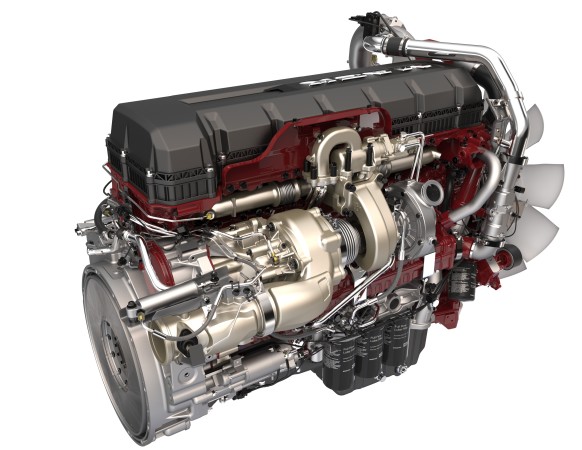Mack to improve fuel economy in 2017 engines, adds Predictive Cruise to mDrive
AUSTIN, Texas — Mack is updating its engines to provide fuel efficiency gains of up to 8.8% through the use of turbo-compounding, a new common rail fuel injection system and other enhancements.
The upgrades will be offered on the 2017 MP7 and MP8 engines; the MP8 improvements will enter production this October and the MP7 updates will take effect in January 2017. Stu Russoli, highway and powertrain products marketing manager with Mack, outlined the updates during a press event here today, on what is Earth Day in the US. The company chose Austin for the launch because it is regularly proclaimed one of the greenest cities in the US, and the changes to Mack’s engine line will reduce greenhouse gas emissions from its products.

The greatest of improvements will be seen in the 445-hp MP8 with turbo-compounding. The system converts hot exhaust gas into 50 additional horsepower but rather than offering more power, Mack is taking the opportunity to improve efficiency by reducing the horsepower generated by the engine. So the 445-horse MP8 will effectively be as fuel-efficient as a 395-hp engine.
“The second turbo runs gears and puts 50 hp back into the crankshaft,” Russoli explained. “We can give you 50 more horsepower on the engine, which we’re not doing. We’re taking that 50 hp and letting the engine rest more, so we’re improving your fuel economy because it’s not working as hard and the exhaust gas is putting 50 hp into that crank.”
Turbo-compounding also allows peak torque to be achieved at 900 rpm, enabling further downspeeding.
Moving from an MP8 today with a non-SuperEconodyne engine and 3.08 rear axle ratio to an MP8 SuperEconodyne with turbo-compounding and 2.46 rear axle ratio will net a fleet an 8.8% fuel economy improvement, Russoli said. And, he added, that’s being conservative, according to powertrain engineers who are working on the project in Hagerstown, Md.
The new MP8 with a 2.64 rear axle ratio and SuperEconodyne powertrain package spec’d without turbo-compounding will still deliver an 8.1% fuel economy gain, Russoli said.
Other improvements include a new common rail fuel injection system and a redesigned wave piston.
“As fuel is injected, it has pockets that will improve the combustion of the fuel, eliminating soot buildup in the piston,” Russoli explained of the wave piston design. Also new is a two-speed coolant pump and a lighter-weight assembled camshaft. The MP8’s cylinder block will be 44 lbs lighter and the MP7 gets several features already built into its bigger brother, including shimless rocker arms and a two-piece valve cover. Those additions will improve serviceability, Russoli noted.
Mack is also offering a new 425 hp rating on its MP7, which Russoli said effectively provides 13-litre power out of an 11-litre engine.
MP7 customers who move from today’s offering in a non-SuperEconodyne spec’ with a 3.08 rear axle ratio to the 2017 engine with SuperEconodyne and a 2.64 rear axle ratio will see fuel economy improvements of 5.1%, according to Mack. Moving to a non-SuperEconodyne and maintaining the same 3.08 rear axle ratio will net a fuel economy gain of 2.1%.
Mack also announced the introduction of predictive cruise to its mDrive automated manual transmission, which has been well received by the market; it is now spec’d on 80% of axle back Mack Pinnacles.
Predictive cruise uses GPS to memorize the specifics of up to 4,500 hills and then stores that information and in the future, optimizes fuel economy to maintain top gear and reduce fuel consumption. Russoli said the feature will offer a 1% fuel economy savings. The truck will accelerate as it approaches a hill but by no more than a couple miles per hour, Russoli said.
It will also maintain the highest available gear, reducing downshifts and will better control speed on the descent, avoiding harsh engine brake applications.
“It’s really good for regional haul and long-haul, anywhere you’re running repetitive routes,” Russoli said.
Have your say
This is a moderated forum. Comments will no longer be published unless they are accompanied by a first and last name and a verifiable email address. (Today's Trucking will not publish or share the email address.) Profane language and content deemed to be libelous, racist, or threatening in nature will not be published under any circumstances.